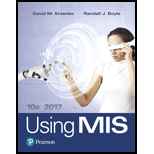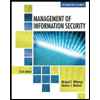
a)
Credit report:
Credit report is a summary of the credit history about lenders and creditors. It has been categorized into four sections they are:
- Personal information of user
- Credit account information like credit card, loans, and mortgages.
- Public record information
- Inquiries
Personal information of user:
This section used to store the user name, contact number, social security number, and employment details.
Credit account information like credit card, loans, and mortgages:
This section contains the information about loans, credit accounts and limits and payment history.
Public record information:
This section used to store the information about the tax, bankruptcies, or court judgment against the user account.
Inquiries:
This section has the business information for overall credit report.
a)
Explanation of Solution
In my credit report, there is no error in both personal information and credit data. The following guidance used to check the credit report for last year.
Guidance to review the credit records:
The user should check the credit report at least once in a year to make sure “no errors” in report and get the information about credit history.
Evaluate the personal identifiable information and debt:
This process used to evaluate all payment history like monthly payments, interest payments, etc. If the personal information wrongly updated on the report, then the user can complain for that.
Check for inaccurate data:
An inaccurate data like mistaken name, mistyped address, or incorrect amount can confuse the user. So, checking for inaccurate data is essential to users.
b)
Credit report:
Credit report is a summary of the credit history about lenders and creditors. It has been categorized into four sections they are:
- Personal information of user
- Credit account information like credit card, loans, and mortgages.
- Public record information
- Inquiries
Personal information of user:
This section used to store the user name, contact number, social security number, and employment details.
Credit account information like credit card, loans, and mortgages:
This section contains the information about loans, credit accounts and limits and payment history.
Public record information:
This section used to store the information about the tax, bankruptcies, or court judgment against the user account.
Inquiries:
This section has the business information for overall credit report.
b)
Explanation of Solution
Actions that are taken by user if they find error in the credit report:
If the user got the error in the credit report, he should take the following actions. They are:
- Inform to the credit bureaus and data furnisher about the error.
- Markup and highlight the mistakes in the credit report
- Request a fresh report from credit bureaus
- Write a dispute letter per error
c)
Credit report:
Credit report is a summary of the credit history about lenders and creditors. It has been categorized into four sections they are:
- Personal information of user
- Credit account information like credit card, loans, and mortgages.
- Public record information
- Inquiries
Personal information of user:
This section used to store the user name, contact number, social security number, and employment details.
Credit account information like credit card, loans, and mortgages:
This section contains the information about loans, credit accounts and limits and payment history.
Public record information:
This section used to store the information about the tax, bankruptcies, or court judgment against the user account.
Inquiries:
This section has the business information for overall credit report.
c)
Explanation of Solution
Identity theft:
- Identity theft is a crime when a hacker access enough information about other person’s identity for financial gain.
- The information can be a signature, name, phone number, or credit card data. Using these personal information, a thief can apply for loan and run up without user knowledge.
Victims of identity theft:
If someone thinks he or she has been the victim of identity theft, he/she should follow some actions to recover his good name and data:
Give the alert on credit file:
After the identity theft, call the credit report agencies and place the fraud alert for the corresponded file.
Request for the credit report and create the identity-theft report:
Request the credit report from credit agencies to calculate theft report. Create the identity-theft report to complain the certain authority.
Contact the authority:
Inform the local law enforcement to take appropriate action for the theft.
Keep the records and originals:
Keep the good notes of all the dealings with creditors and law enforcement. Send the valuable documents as photocopies in certified mail.
Want to see more full solutions like this?
Chapter 10 Solutions
Using MIS (10th Edition)
- What IETF protocol is NetFlow associated with? Group of answer choices IPX/SPX IPIX HTTPS SSHarrow_forwardHow can I perform Laplace Transformation when using integration based on this?arrow_forwardWrite an example of a personal reflection of your course. - What you liked about the course. - What you didn’t like about the course. - Suggestions for improvement. Course: Information and Decision Sciences (IDS) The Reflection Paper should be 1 or 2 pages in length.arrow_forward
- using r languagearrow_forwardI need help in explaining how I can demonstrate how the Laplace & Inverse transformations behaves in MATLAB transformation (ex: LIke in graph or something else)arrow_forwardYou have made the Web solution with Node.js. please let me know what problems and benefits I would experience while making the Web solution here, as compared to any other Web solution you have developed in the past. what problems and benefits/things to keep in mind as someone just learningarrow_forward
- PHP is the server-side scripting language. MySQL is used with PHP to store all the data. EXPLAIN in details how to install and run the PHP/MySQL on your computer. List the issues and challenges I may encounter while making this set-up? why I asked: I currently have issues logging into http://localhost/phpmyadmin/ and I tried using the command prompt in administrator to reset the password but I got the error LOCALHOST PORT not found.arrow_forwardHTML defines content, CSS defines layout, and JavaScript adds logic to the website on the client side. EXPLAIN IN DETAIL USING an example.arrow_forwardusing r languangearrow_forward
 Principles of Information Systems (MindTap Course...Computer ScienceISBN:9781305971776Author:Ralph Stair, George ReynoldsPublisher:Cengage Learning
Principles of Information Systems (MindTap Course...Computer ScienceISBN:9781305971776Author:Ralph Stair, George ReynoldsPublisher:Cengage Learning Enhanced Discovering Computers 2017 (Shelly Cashm...Computer ScienceISBN:9781305657458Author:Misty E. Vermaat, Susan L. Sebok, Steven M. Freund, Mark Frydenberg, Jennifer T. CampbellPublisher:Cengage Learning
Enhanced Discovering Computers 2017 (Shelly Cashm...Computer ScienceISBN:9781305657458Author:Misty E. Vermaat, Susan L. Sebok, Steven M. Freund, Mark Frydenberg, Jennifer T. CampbellPublisher:Cengage Learning Principles of Information Systems (MindTap Course...Computer ScienceISBN:9781285867168Author:Ralph Stair, George ReynoldsPublisher:Cengage Learning
Principles of Information Systems (MindTap Course...Computer ScienceISBN:9781285867168Author:Ralph Stair, George ReynoldsPublisher:Cengage Learning Fundamentals of Information SystemsComputer ScienceISBN:9781305082168Author:Ralph Stair, George ReynoldsPublisher:Cengage Learning
Fundamentals of Information SystemsComputer ScienceISBN:9781305082168Author:Ralph Stair, George ReynoldsPublisher:Cengage Learning Management Of Information SecurityComputer ScienceISBN:9781337405713Author:WHITMAN, Michael.Publisher:Cengage Learning,Np Ms Office 365/Excel 2016 I NtermedComputer ScienceISBN:9781337508841Author:CareyPublisher:Cengage
Management Of Information SecurityComputer ScienceISBN:9781337405713Author:WHITMAN, Michael.Publisher:Cengage Learning,Np Ms Office 365/Excel 2016 I NtermedComputer ScienceISBN:9781337508841Author:CareyPublisher:Cengage





